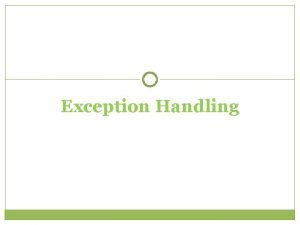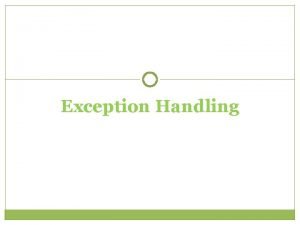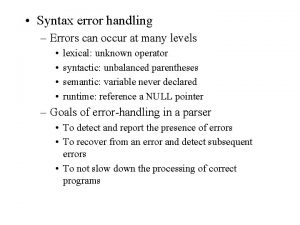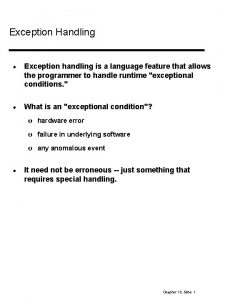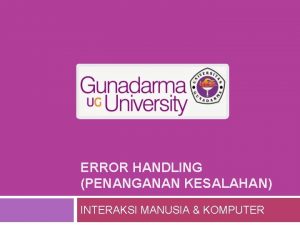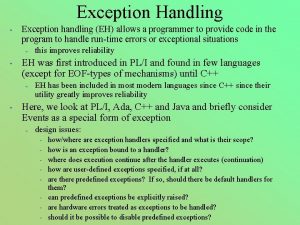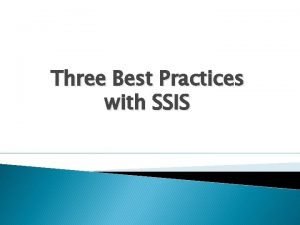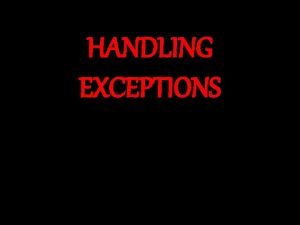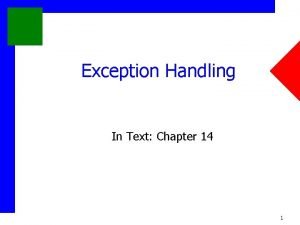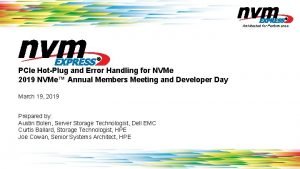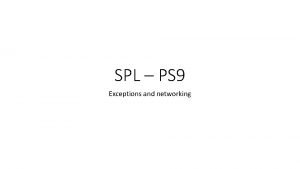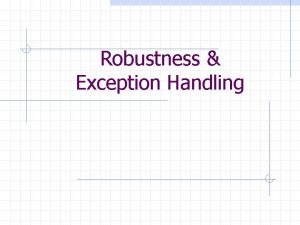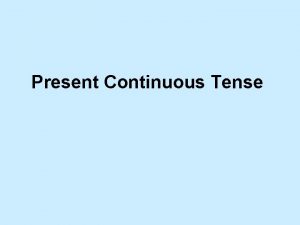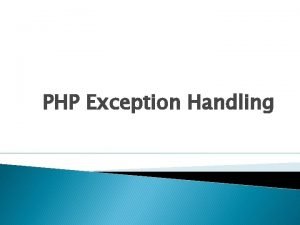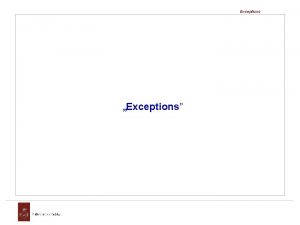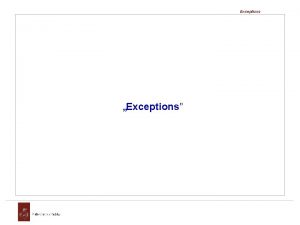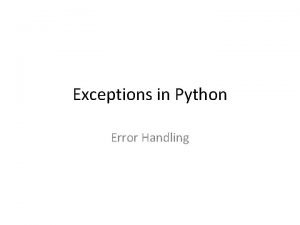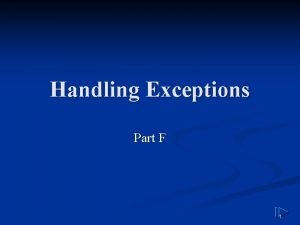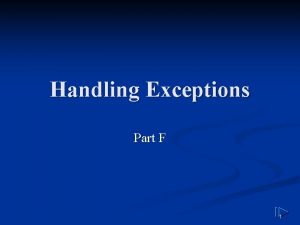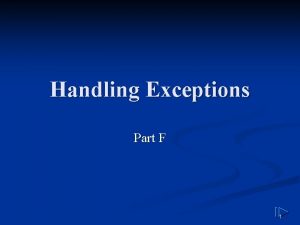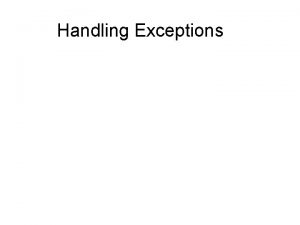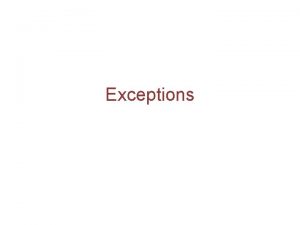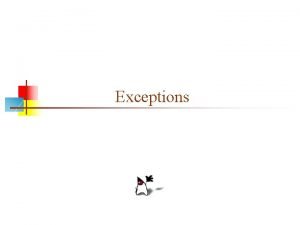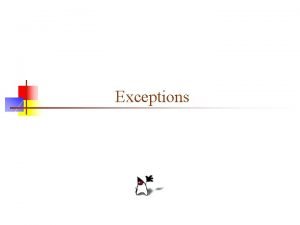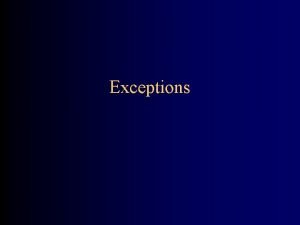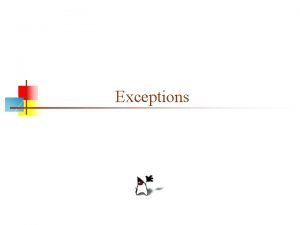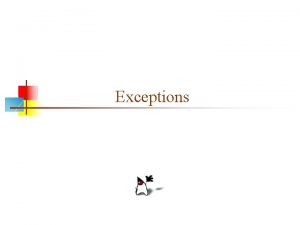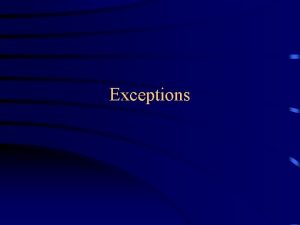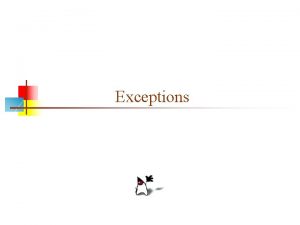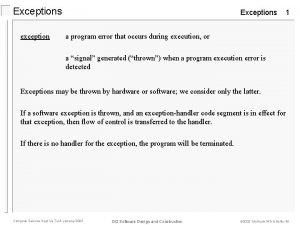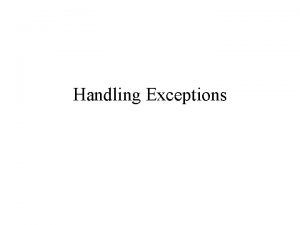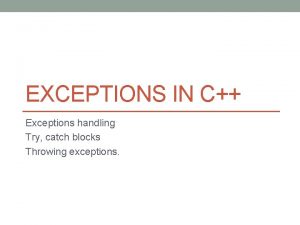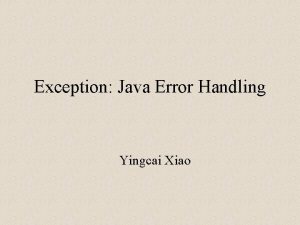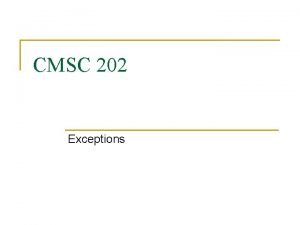Exceptions Error Handling in NET Error Handling Old






















- Slides: 22

Exceptions Error Handling in. NET

Error Handling Old way (Win 32 API and COM): My. Function() { error_1 = do. Something(); if (error_1) display error else { continue processing if (error_2) display error else continue processing } }

How is Error Handled in. NET? It uses Exception handling enables programmers to remove error-handling code from the “main line” of the program’s execution. Examples: Without exceptions: Divide. By. Zero. No. Exception. Handling. cs With exceptions: Divide. By. Zero. Test. sln

Syntax try { // code that requires common cleanup or // exception-recovery operations } catch (Invalid. Operation. Exception) { //code that recovers from an Invalid. Operation. Exception // (or any exception type derived from it) } catch (Some. Other. Exception) { // code that recovers from an Some. Other. Exception // (or any exception type derived from it) } catch { // code that recovers from any kind of exception // when you catch any exception, you usually re-throw; } finally { // code that cleans up any operations started // within the try block. This code ALWAYS executes. }

try block A try block contains code that requires common cleanup or exception-recovery operations. The cleanup code should be put in a single finally block. The exception recovery code should be put in one or more catch blocks. Create one catch block for each kind of type you want to handle. A try block must have at least one catch or finally block.

catch block A catch block contains code to execute in response to an exception. If the code in a try block doesn’t cause an exception to be thrown, the CLR will never execute the code in any of its catch blocks. You may or may not specify a catch type in parantheses after catch : The catch type must be of type System. Exception or a type that derived from System. Exception If there is no catch type specified, that catch block handles any exception. This is equivalent to having a catch block that specifies System. Exception as a catch type. CLR searches for a matching catch type from top to bottom. If CLR cannot find any catch type that matches the exception, CLR continues searching up the callstack to find a catch type.

catch block Once the catch block that matches the exception is found, you have 3 choices: 1. 2. 3. Re-throw the same exception, notifying the higher-up call stack of the exception Throw a different exception, giving richer exception information to code higher-up in the call stack Let the code continue from the bottom of the catch block In choices 1 -2, an exception is thrown and code starts looking for a catch block whose type matches the exception thrown In choice 3, the finally block is executed You can also specify a variable name like catch(Exception e) to access information specific to the exception.

finally block The CLR does not completely eliminate memory leaks. Why? Even though GC does automatic memory clean-up, it only cleans up if there are no references kept on the object. Even there may be a delay until the memory is required. Thus, memory leaks can occur if programmers inadvertently keep references to unwanted objects. C# provides the finally block, which is guaranteed to execute regardless of whether an exception occurs. If the try block executes without throwing, the finally block executes. If the try block throws an exception, the finally block still executes regardless of whether the exception is caught. This makes the finally block ideal to release resources from the corresponding try block. Example: Using. Exceptions. cs

finally block Local variables in a try block cannot be accessed in the corresponding finally block, so variables that must be accessed in both should be declared before the try block. Placing the finally block before a catch block is a syntax error. A try block does not require a finally block, sometimes no clean-up is needed. A try block can have no more than one finally block. Avoid putting code that might throw in a finally block. Exception handling will still work but the CLR will not keep the information about the first exception just thrown in the corresponding try block.

using The using statement simplifies writing code in which you obtain a resource. The general form of a using statement is: using ( Example. Object e = new Example. Object() ) { e. Some. Method(); } This using statement code is equivalent to: { } Example. Object e = new Example. Object(); try { e. Some. Method(); } finally { if ( e != null ) ( ( IDisposable ) e ). Dispose(); }

System. Exception In. NET, only objects of class Exception and its derived classes may be thrown and caught. Exceptions thrown in other. NET languages can be caught with the general catch clause. Class Exception is the base class of. NET’s exception class hierarchy. A catch block can use a base-class type to catch a hierarchy of related exceptions. A catch block that specifies a parameter of type Exception catch all exceptions.

System. Exception Properties Class Exception’s properties are used to formulate error messages indicating a caught exception. Property Message stores the error message associated with an Exception object. Property Stack. Trace contains a string that represents the methodcall stack. When an exception occurs, a programmer might use a different error message or indicate a new exception type. The original exception object is stored in the Inner. Exception property. Other properties: Help. Link specifies the location of a help file that describes the problem. Source specifies the name of the application or object that caused the exception. Target. Site specifies the method where the exception originated.

Common. NET Exceptions The CLR generates System. Exceptions, derived from class Exception, which can occur at any point during program execution. If a program attempts to access an out-of-range array index, the CLR throws an exception of type Index. Out. Of. Range. Exception. Attempting to use a null reference causes a Null. Reference. Exception.

FCL-Defined Exceptions System. Exception System. Application. Exception System. Access. Violation. Exception System. Argument. Exception System. Argument. Null. Exception System. Argument. Out. Of. Range. Exception System. Format. Exception System. Index. Out. Of. Range. Exception System. Invalid. Cast. Exception System. IOException System. IO. File. Not. Found. Exception System. Not. Implemented. Exception System. Null. Reference. Exception System. Out. Of. Memory. Exception

Determining Which Exceptions a FCL Method Throws Example: Convert. To. Int 32 Search for “Convert. To. Int 32” in the Index of the Visual Studio online documentation. Select the document entitled Convert. To. Int 32 Method. In the document that describes the method, click the link To. Int 32(String). The Exceptions section indicates that method Convert. To. Int 32 throws two exception types.

What are Exceptions? They are not an “exceptional event”, a rare event that occurs. They are not just errors. They are specific results returned when a method could not complete its task. Example: when should Transfer throw? public class Account { public void Transfer(Account from, Account to, decimal amount) { … } } When the Transfer method detects any of such possible conditions and cannot transfer the money, then it should notify the caller that it failed by throwing an exception.

Choosing the Exception to throw When implementing your own methods, you should throw an exception when the method cannot complete its task. Associating each type of malfunction with an appropriately named exception class improves program clarity. 1. What Exception-derived type are you going to throw? 2. You must select a meaningful type You can select a type defined in FCL that matches your semantics If not, you may need to define your own type Your exception type hierarchy should be shallow and wide: that is, create as few base classes as possible What string message are you going to pass to the exception type’s constructor? If the exception is handled, no one will see this exception message. If the exception is unhandled, then the code will probably log this message and a developer would want to understand what went wrong using this message. So the message should give enough detail as possible. Message does not need to be localized.

User-Defined Exceptions User-defined exception classes should derive directly or indirectly from class Exception of namespace System. Exceptions should be documented so that other developers will know how to handle them. User-defined exceptions should define three constructors: a parameterless constructor a constructor that receives a string argument (the error message) a constructor that receives a string argument and an Exception argument (the error message and the inner exception object)

User-Defined Exception Example Square. Root. Test

Do not catch everything! try { // code that might fail… } catch (Exception) { … } How can you write code that can recover from all situations? ? ? A class library should never swallow all exceptions. The application should get a chance to handle the exception. You can catch all exceptions only if you are going to process it and re-throw it again.

Benefits of Exceptions The ability to keep cleanup code in a dedicated location and making sure this cleanup code will execute The ability to keep code that deals with exceptional situations in a central place The ability to locate and fix bugs in the code Unified error handling: all. NET Framework classes throw exceptions to handle error cases Old Win 32 APIs and COM returns a 32 -bit error code. Exceptions include a string description of the problem. Exceptions also include a stack trace that tells you the path application took until the error occurred. You can also put any information you want in a user-defined exception of your own. The caller could ignore the error returned by a Win 32 API, now the caller cannot continue with exceptions. If the application cannot handle the exception, CLR can terminate the application.

Exercise Modify your calculator homework to now handle exceptions thrown by Convert class Also create a new exception to handle invalid operator.
 Vb.net exception handling
Vb.net exception handling Exception handling in vb.net
Exception handling in vb.net How old are you what's your name
How old are you what's your name Once upon a time there lived an old woman
Once upon a time there lived an old woman Once upon a time there lived an old man and an old woman
Once upon a time there lived an old man and an old woman Once upon a time there lived a family of bears
Once upon a time there lived a family of bears Syntax error handling
Syntax error handling Contoh kesalahan leksikal
Contoh kesalahan leksikal Withoutexceptionhandling
Withoutexceptionhandling Jenis – jenis kesalahan user adalah slip
Jenis – jenis kesalahan user adalah slip Error handling code
Error handling code Pl/i error handling
Pl/i error handling Ssis logging best practices
Ssis logging best practices Exception handling pl/sql
Exception handling pl/sql Pl/i error handling
Pl/i error handling Pcie hotplug
Pcie hotplug Spl exceptions
Spl exceptions Robustness in java
Robustness in java Stark law exceptions
Stark law exceptions Present continuous tense rules
Present continuous tense rules Php exception handling
Php exception handling Koch's postulates exceptions
Koch's postulates exceptions Koch's postulates exceptions
Koch's postulates exceptions
